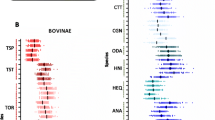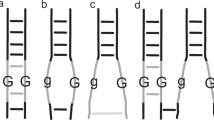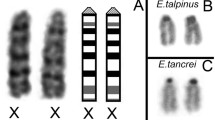Summary
The examination of synaptic data and localization of chromosomal breakpoints in a review of human pericentric inversions suggest that synaptic and recombination behaviour in rearranged chromosomes during meiosis can be predicted by determining the subband in which the breakpoint is located. According to this hypothesis, it can be postulated that loops in pericentric inversions are routinely formed only in cases when both breaks occur in G-light bands, whith the genetic consequences of crossing-over. In other cases, heterosynapsis is accomplished without previous homosynapsis, thereby minimizing the production of unbalanced gametes.
Similar content being viewed by others
References
Ashley T (1988) G-band position on meiotic synapsis and crossing-over. Genetics 118:307–317
Batanian J, Hulten MA (1987) Electron microscopic investigations of synaptonemal complexes in an infertile human male carrier of a pericentric inversion inv(1) (p32;q42). Regular loop formation but defective synapsis including a possible interchromosomal effect. Hum Genet 76:81–86
Chandley AC (1986) A model for effective pairing and recombination at meiosis based on early replicating sites (R-bands) along chromosomes. Hum Genet 72:50–57
Chandley AC, McBeath S, Speed RM, Yorston L, Hargreave TB (1987) Pericentric inversion in human chromosome 1 and the risk for male sterility. J Med Genet 24:325–334
French Collaborative Study (1986) Pericentric inversions in man. Ann Génét (Paris) 29:129–168
Gabriel-Robez O, Ratomponirina C, Rumpler Y, Le Marec B, Luciani JM, Guichaoua MR (1986) Synapsis and synaptic adjustment in an infertile human male heterozygous for a pericentric inversion in chromosome 1. Hum Genet 72:148–152
Gabriel-Robez O, Ratomponirina C, Croquette M, Maetz JL, Couturier J, Rumpler Y (1987) Reproductive failure and pericentric inversion in man. Andrologia 19:662–669
Gabriel-Robez O, Ratomponirina C, Croquette M, Couturier J, Rumpler Y (1988) Synaptonemal complexes in a subfertile man with a pericentric inversion in chromosome 21: heterosynapsis without previous homosynapsis. Cytogenet Cell Genet 48:84–87
Ganner E, Evans HJ (1971) The relationship between patterns of DNA replication and of quinacrine fluorescence in the human chromosome complement. Chromosoma 35:326–341
Guichaoua MR, Gabriel-Robez O, Ratomponirina C, Delafontaine D, Le Marec B, Taillemite JL, Rumpler Y, Luciani JM (1986) Meiotic behaviour of familial pericentric inversions of chromosomes 1 and 9. Ann Génét (Paris) 29:207–214
Holmquist G, Gray M, Porter T, Jordan J (1982) Characterization of Giemsa dark- and light-band DNA. Cell 31:121–129
Luciani JM, Guichaoua MR, Cau P, Devictor B, Salagnon N (1988) Differential elongation of autosomal pachytene bivalents related to their DNA content in human spermatocytes. Chromosoma 97: 19–25
Moses MJ, Counce SJ, Paulson DF (1975) Synaptonemal complex complement of man in spreads of spermatocytes with details of the sex chromosome pair. Science 187:363–365
Nicklas RB (1961) Recurrent pole-to-pole movements of the sex chromosome during prometaphase I in Melanoplus differentialis spermatocytes. Chromosoma 12:97–115
Nicklas RB (1968) Chromosome segregation: an explanation of kinetochore reorientation. Genetics 60:207–208
Saadallah N, Hulten M (1986) EM investigations of surface spread synaptonemal complexes in a human male carrier of a pericentric inversion inv(13) (p12q14): the role of heterosynapsis for spermatocyte survival. Ann Hum Genet 50:369–383
Solari AJ (1980) Synaptonemal complexes and associated structures in microspread human spermatocytes. Chromosoma 81:315–337
Stack SM (1984) Heterochromatin, the synaptonemal complex and crossing-over. J Cell Sci 71:159–176
Traut W, Winking H, Adolph S (1984) An extra segment in chromosome 1 of the wild Mus musculus: a C-band positive homogeneously staining region. Cytogenet Cell Genet 38:290–297
Author information
Authors and Affiliations
Rights and permissions
About this article
Cite this article
de Perdigo, A., Gabriel-Robez, O. & Rumpler, Y. Correlation between chromosomal breakpoint positions and synaptic behaviour in human males heterozygous for a pericentric inversion. Hum Genet 83, 274–276 (1989). https://doi.org/10.1007/BF00285171
Received:
Revised:
Issue Date:
DOI: https://doi.org/10.1007/BF00285171




